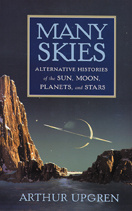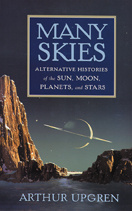
212 pages, 6 x 9
6 illustrations, 3 tables, 13 figures
Paperback
Release Date:09 Apr 2012
ISBN:9780813553504
Many Skies
Alternative Histories of the Sun, Moon, Planets, and Stars
Rutgers University Press
What if Earth had several moons or massive rings like Saturn? What if the Sun were but one star in a double-star or triple-star system? What if Earth were the only planet circling the Sun?
These and other imaginative scenarios are the subject of Arthur Upgren's inventive book Many Skies: Alternative Histories of the Sun, Moon, Planets, and Stars. Although the night sky as we know it seems eternal and inevitable, Upgren reminds us that, just as easily, it could have been very different.
Had the solar sytem happened to be in the midst of a star cluster, we might have many more bright stars in the sky. Yet had it been located beyond the edge of the Milky Way galaxy, we might have no stars at all. If Venus or Mars had a moon as large as ours, we would be able to view it easily with the unaided eye. Given these or other alternative skies, what might Ptolemy or Copernicus have concluded about the center of the solar sytem and the Sun?
This book not only examines the changes in science that these alternative solar, stellar, and galactic arrangements would have brought, it also explores the different theologies, astrologies, and methods of tracking time that would have developed to reflect them. Our perception of our surroundings, the number of gods we worship, the symbols we use in art and literature, even the way we form nations and empires are all closely tied to our particular (and accidental) placement in the universe.
Many Skies, however, is not merely a fanciful play on what might have been. Upgren also explores the actual ways that human interferences such as light pollution are changing the night sky. Our atmosphere, he warns, will appear very different if we have belt of debris circling the globe and blotting out the stars, as will happen if advertisers one day pollute space with brilliant satellites displaying their products.
From fanciful to foreboding, the scenarios in Many Skies will both delight and inspire reflection, reminding us that ours is but one of many worldviews based on our experience of a universe that is as much a product of accident as it is of intention.
These and other imaginative scenarios are the subject of Arthur Upgren's inventive book Many Skies: Alternative Histories of the Sun, Moon, Planets, and Stars. Although the night sky as we know it seems eternal and inevitable, Upgren reminds us that, just as easily, it could have been very different.
Had the solar sytem happened to be in the midst of a star cluster, we might have many more bright stars in the sky. Yet had it been located beyond the edge of the Milky Way galaxy, we might have no stars at all. If Venus or Mars had a moon as large as ours, we would be able to view it easily with the unaided eye. Given these or other alternative skies, what might Ptolemy or Copernicus have concluded about the center of the solar sytem and the Sun?
This book not only examines the changes in science that these alternative solar, stellar, and galactic arrangements would have brought, it also explores the different theologies, astrologies, and methods of tracking time that would have developed to reflect them. Our perception of our surroundings, the number of gods we worship, the symbols we use in art and literature, even the way we form nations and empires are all closely tied to our particular (and accidental) placement in the universe.
Many Skies, however, is not merely a fanciful play on what might have been. Upgren also explores the actual ways that human interferences such as light pollution are changing the night sky. Our atmosphere, he warns, will appear very different if we have belt of debris circling the globe and blotting out the stars, as will happen if advertisers one day pollute space with brilliant satellites displaying their products.
From fanciful to foreboding, the scenarios in Many Skies will both delight and inspire reflection, reminding us that ours is but one of many worldviews based on our experience of a universe that is as much a product of accident as it is of intention.
Art Upgren not only reminds us of the simple pleasures of star gazing, he reconnects us with the generations of those who have dared to ask how it all works. Upgren's book thus carves a path along which we can reacquaint ourselves with the universe.
Upgren has produced an intriguing book. He uses 'what-if' scenarios to show how astronomical history might be changed and how current knowledge about astronomy could be applied to these situations. This book is not just for the science fiction aficionado, but for readers to ponder as they simultaneously learn astronomy. Recommended.
Many Skies offers a series of suggestions that are likely to stimulate reflection on how and why the science of astronomy developed and evolved.
Art Upgren not only reminds us of the simple pleasures of star gazing, he reconnects us with the generations of those who have dared to ask how it all works. Upgren's book thus carves a path along which we can reacquaint ourselves with the universe.
Clearly written and easy to understand, [this] book will point you to the stars in a way that should make them lasting friends.
Upgren has produced an intriguing book. He uses 'what-if' scenarios to show how astronomical history might be changed and how current knowledge about astronomy could be applied to these situations. This book is not just for the science fiction aficionado, but for readers to ponder as they simultaneously learn astronomy. Recommended.
Arthur Upgren's marvelous look at our place in the Universe deals with profound questions. What if things didn't turn out exactly as they did-would we still be here? By studying these questions, we gain a much better appreciation of how lucky we are to enjoy life on this precious planet Earth.
Many Skies offers a series of suggestions that are likely to stimulate reflection on how and why the science of astronomy developed and evolved.
Arthur Upgren is emeritus professor of astronomy at Wesleyan University and senior research scientist at Yale University. He is also the author of several popular books on science and astronomy, including Night Has a Thousand Eyes and The Turtle and the Stars: Observations of an Earthbound Astronomer.
Part I: The Sun and the Moon
Our Three Moons
Within a Triple Star
Our Backward Stellar Magnitude System
An Improper Proper Motion
All Our Yesterdays
We Are Alone
Part II: The Planets
The Rings of Earth
Next Door to a Giant
Double Planet
Debris in the Solar System
Seasons of Paradox
More Than One Pluto
Part III: The Stars
What if the Sun were Red? or Blue?
The Vernal Equinox Lies in Virgo
Vega and Deneb Change Places
The Pleiades Star Cluster is as Close as the Hyades
The Great Popcorn Balls
The Milky Way Lies along our Equator
We Are Alone II
Part IV: Homemade Skies
Ring of Rubbish
The Tangled Skein of Celestial Mechanics
A Second Chance
Chicxulub, the Worst Sky of All
Our Three Moons
Within a Triple Star
Our Backward Stellar Magnitude System
An Improper Proper Motion
All Our Yesterdays
We Are Alone
Part II: The Planets
The Rings of Earth
Next Door to a Giant
Double Planet
Debris in the Solar System
Seasons of Paradox
More Than One Pluto
Part III: The Stars
What if the Sun were Red? or Blue?
The Vernal Equinox Lies in Virgo
Vega and Deneb Change Places
The Pleiades Star Cluster is as Close as the Hyades
The Great Popcorn Balls
The Milky Way Lies along our Equator
We Are Alone II
Part IV: Homemade Skies
Ring of Rubbish
The Tangled Skein of Celestial Mechanics
A Second Chance
Chicxulub, the Worst Sky of All




